What Is SEO?
Search engine optimization (SEO) is the process of continuously improving your site’s organic rankings on search engines such as Google, YouTube, Amazon, and Bing.
SEO is a popular digital marketing channel because higher search engine rankings can drive targeted traffic to your website.
Which ultimately can lead to more leads and paying customers.
For example, 22,000 people search for your business’s product or service each month.
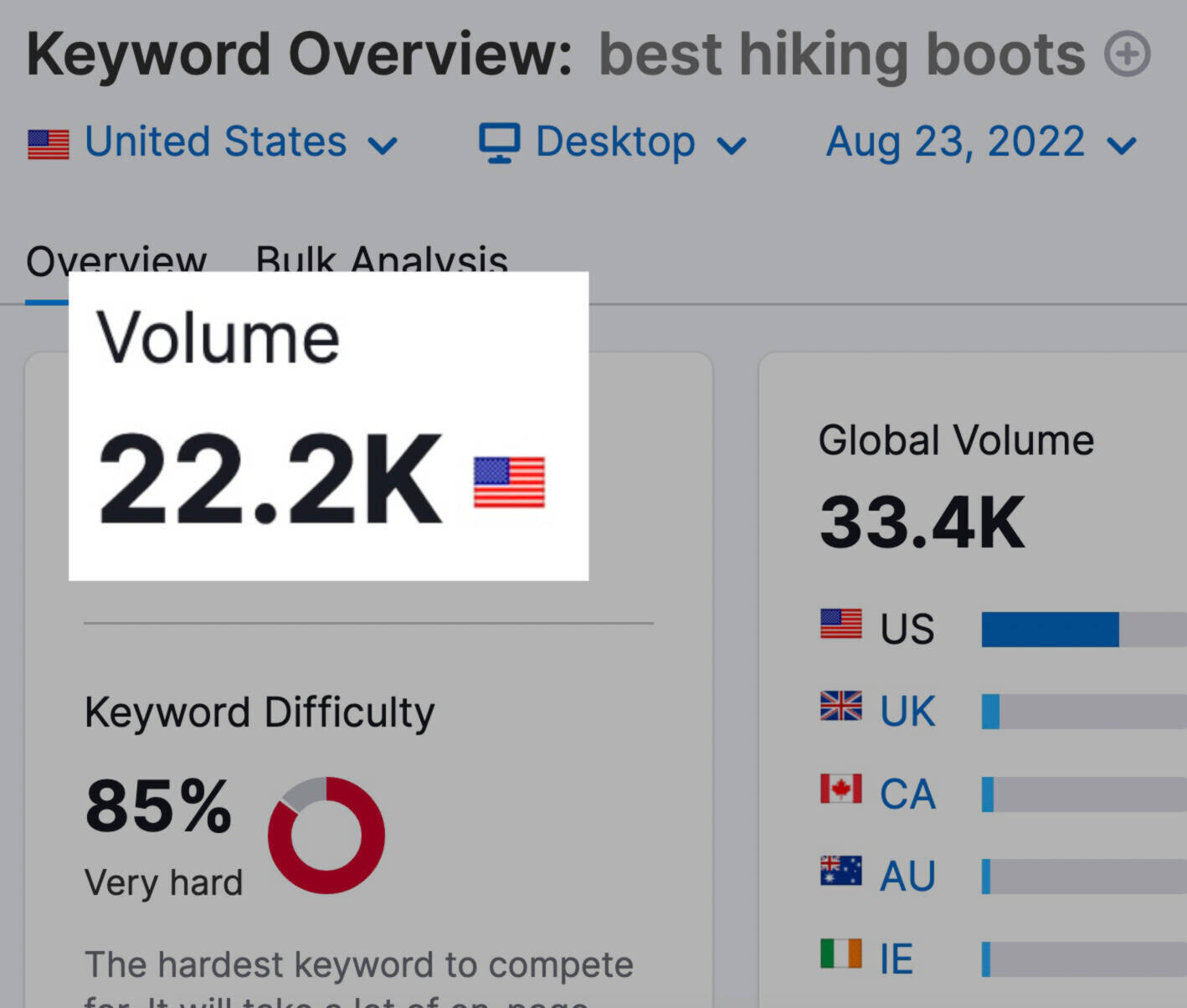
If you can rank #1 in Google for that search term, that can equal a few thousand targeted people visiting your site every single month.
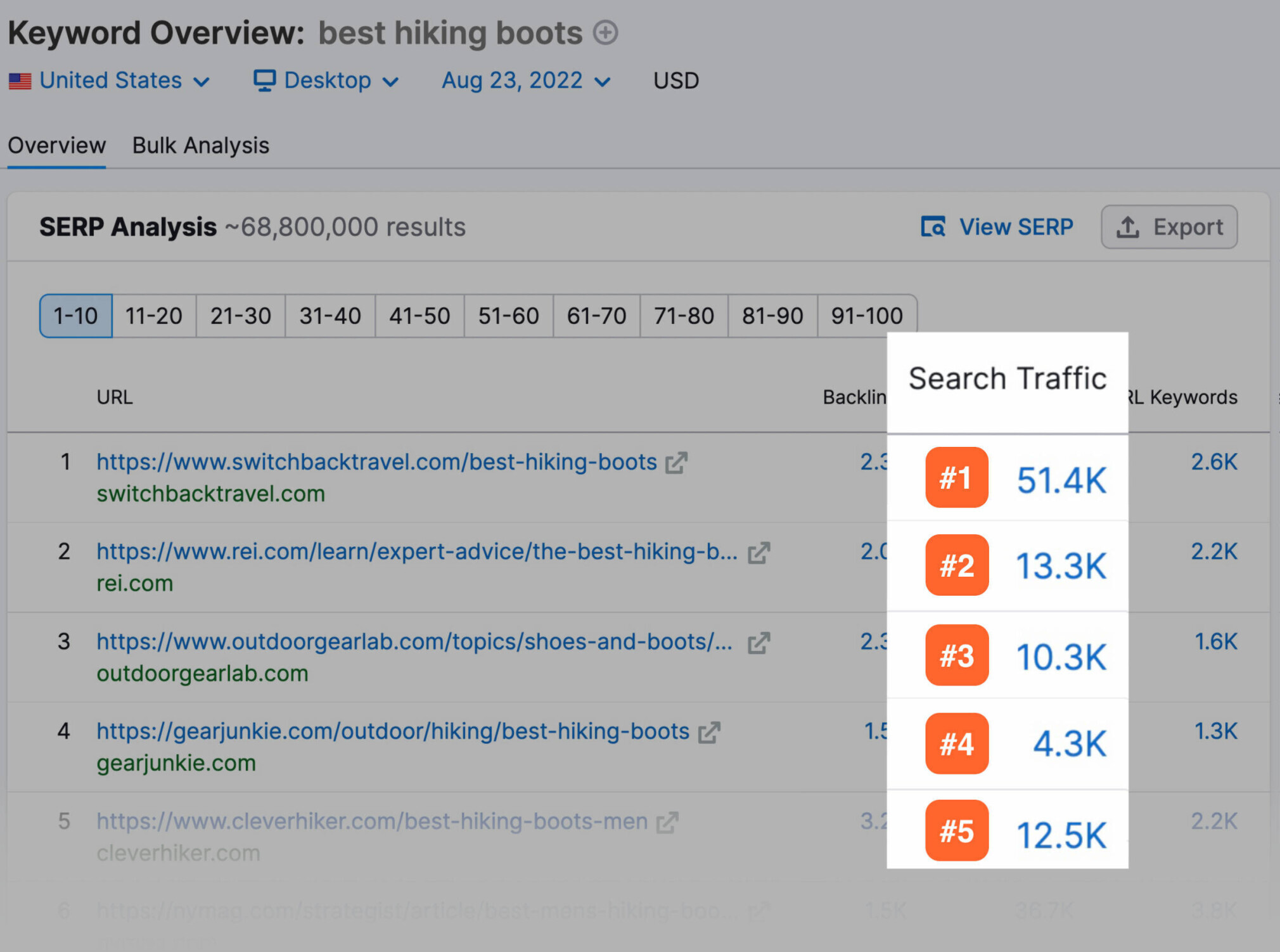
In practice, SEO typically involves:
Creating high-quality content Monitoring your site’s technical health Building links from other sites Ensuring your site loads quickly Having a site that’s easy to use and navigate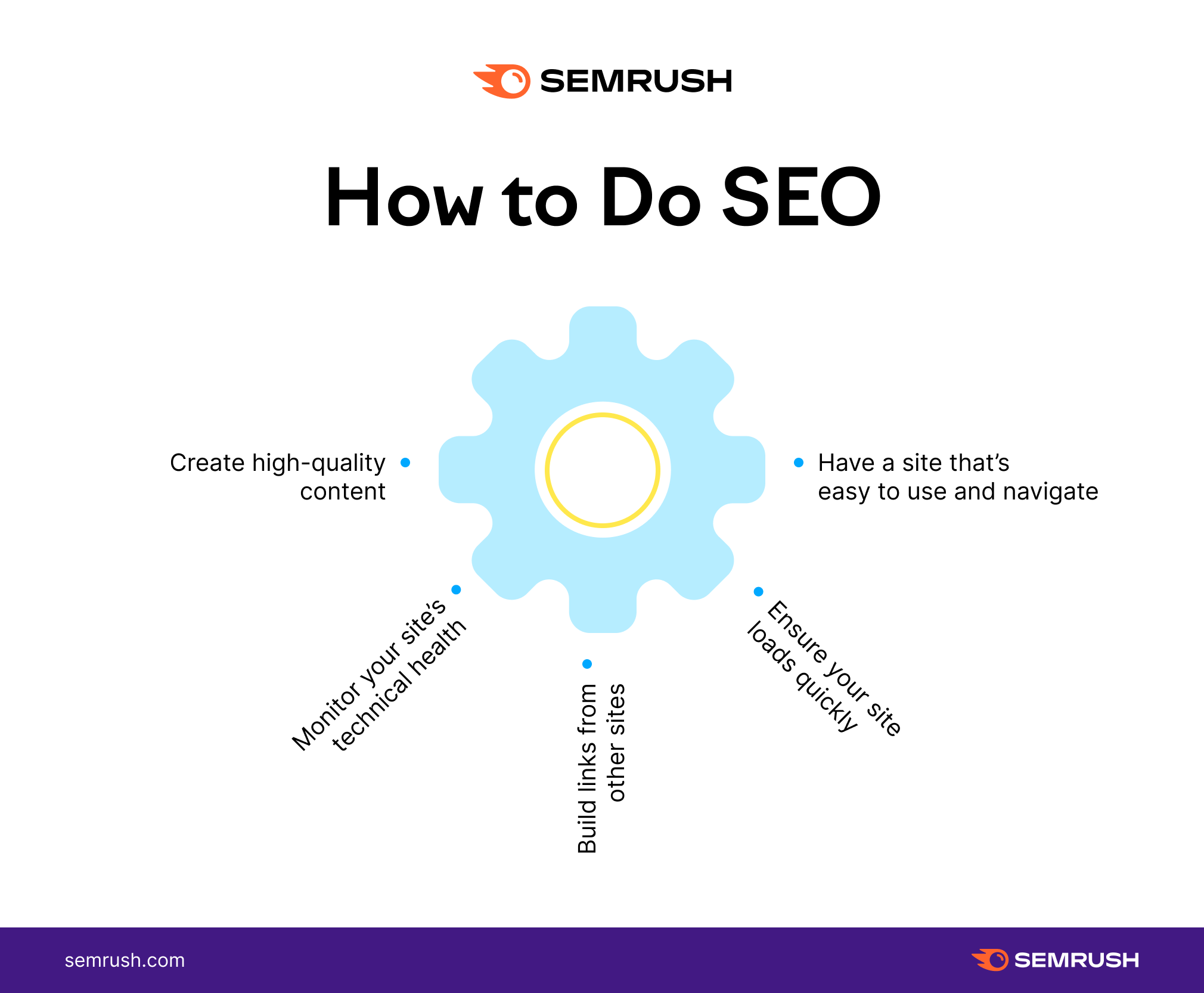
Why Is SEO Important?
SEO is important because, unlike PPC or social media ads, it brings “free” traffic to your site.
Ranking highly on a results page means you’ll get a lot of free clicks. After all, 65% of Google searchers click on organic results (i.e., not the ads).

In other words, once you rank highly for your target keywords, you’ll get a pipeline of passive traffic month after month.
Of course, SEO takes time, effort, and resources.
But the main benefit of SEO versus other channels is that it generates “passive” traffic to your website over time.
For example, take a look at the personal finance website NerdWallet.

Their website generates 16.9 million visitors each month from SEO.
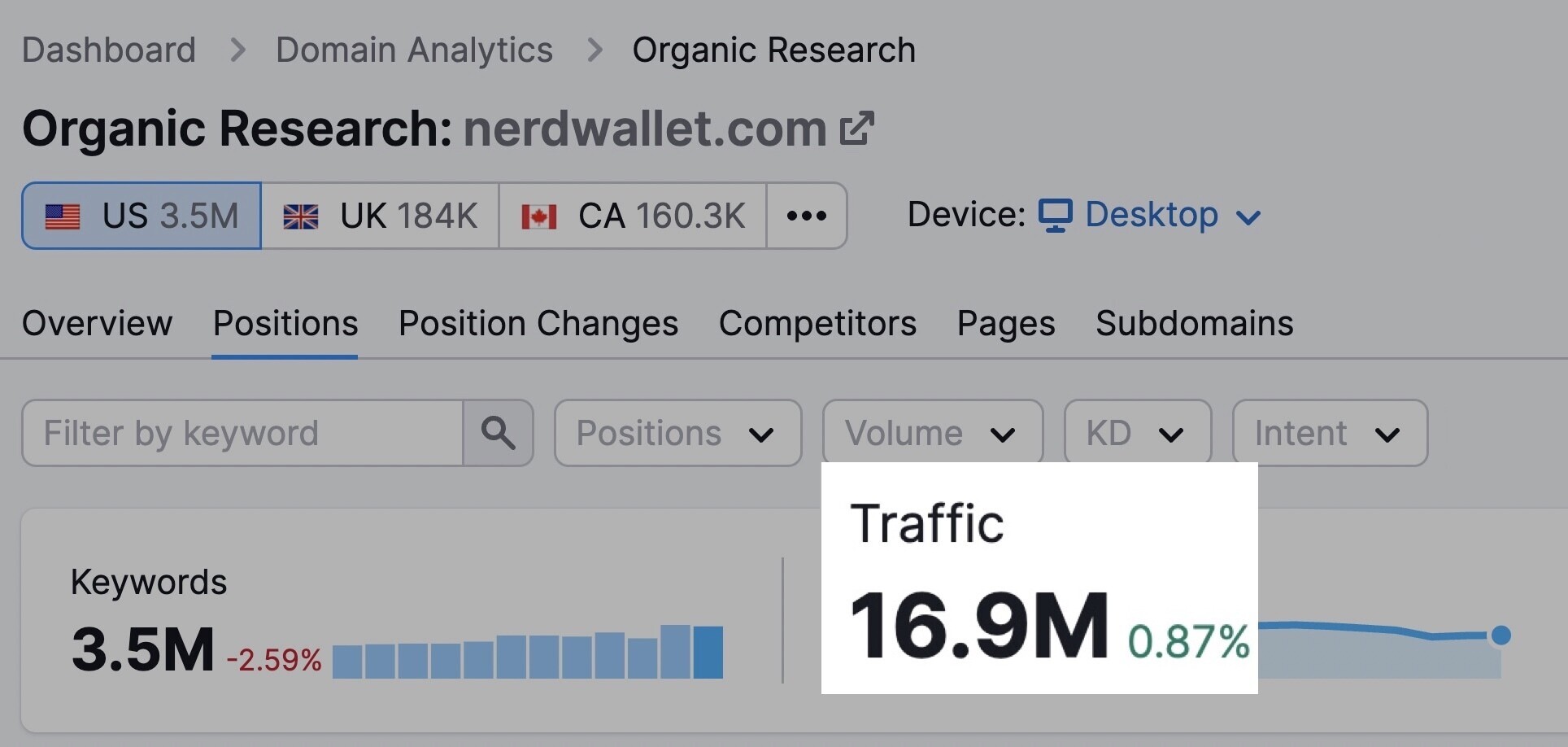
In fact, founder Tim Chen even cites SEO as a big reason that their site became so successful (NerdWallet is actually now a public company).
So if a site can go from zero to publicly traded on the Nasdaq using SEO, do you think that it can help grow your small business? It certainly can.
But before we get into the specific steps and tactics, it’s important to understand how search engines (specifically Google) work under the hood.
How Search Engines Work
Search engines like Google use relatively complex processes (known as “algorithms”) to organize and rank content.
These algorithms take literally hundreds of ranking factors into account to decide where a specific webpage should rank.
Important Note: “Google rankings” refers to the non-paid organic results. Paid results (ads, basically) are a totally separate channel.
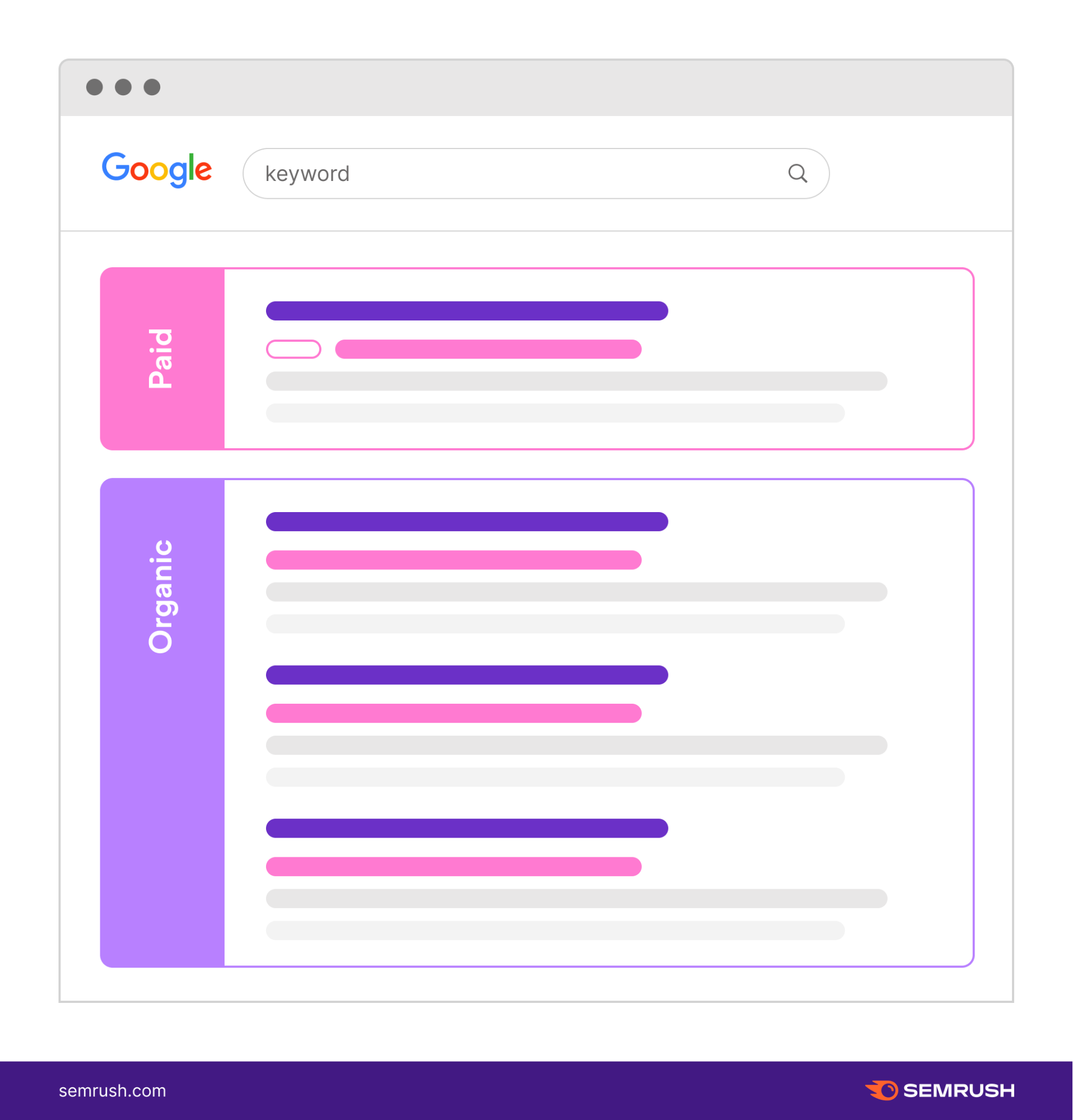
In short, search engines take in digital content and organize this information into results pages. The ultimate goal is to make searchers happy with the results they find on the search engine results pages (SERPs).
Fortunately, you don’t need to know about all of these factors to succeed with SEO.
But it is helpful to understand the process that Google uses to find and ultimately rank websites.
Google’s Ranking Process
Google uses the following stages to find and rank content:
Crawling: Google uses “bots” to crawl the web and look for new or updated pages. In order for Google to find a page, the page must have links pointing to it. Generally speaking, the more links a page has to it, the easier it is for Google to locate that page. Indexing: Next, Google analyzes each page that the bots discover and tries to make sense of what the page is about. Google will look at things like content, images, and other media files. It then stores this information in its Google Index (in other words, its database). Serving: Google determines which pages are most relevant to users’ search queries and ranks them in the SERPs.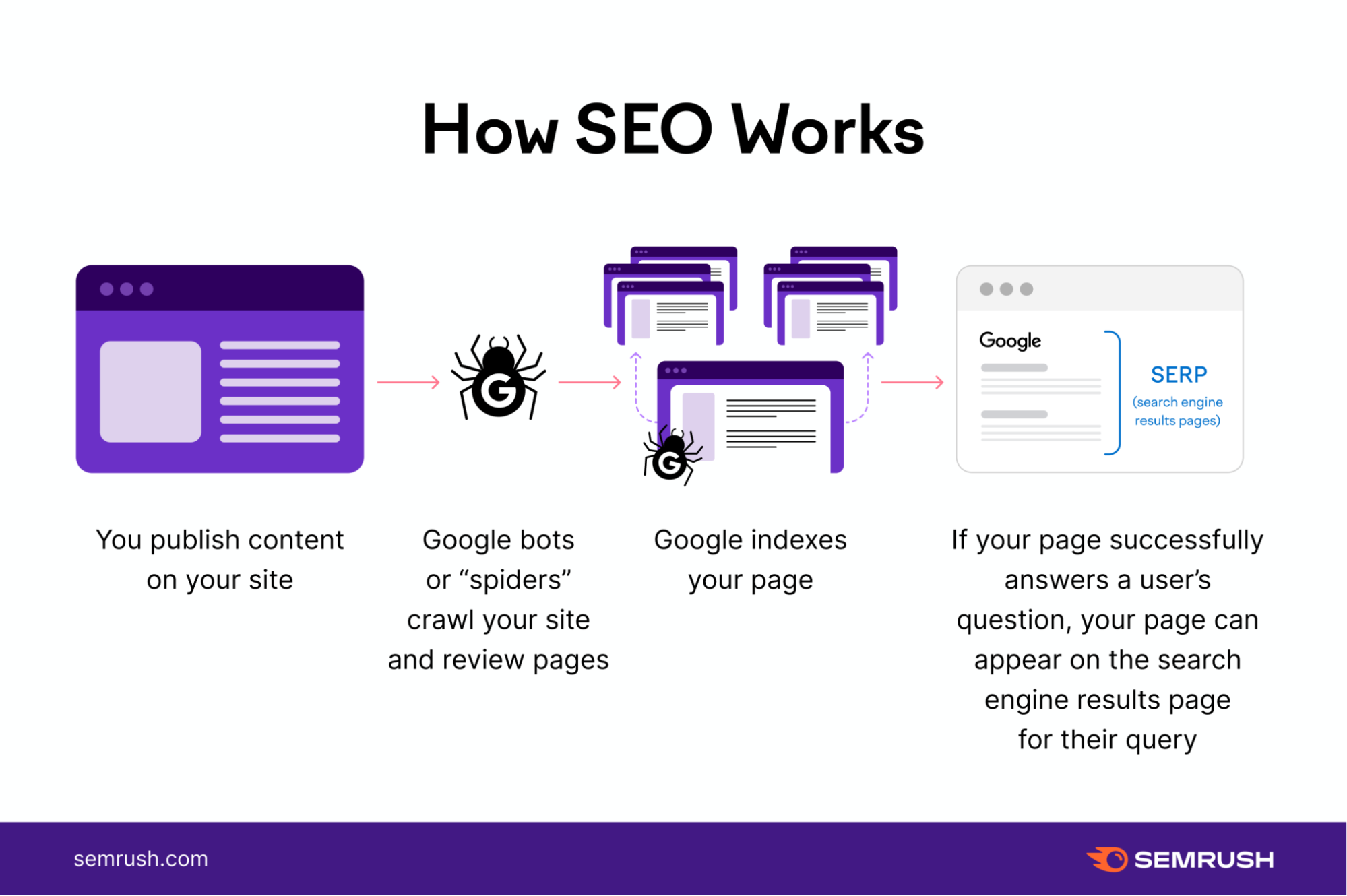
Important Google Ranking Factors in 2022
SEO changes super quickly. In fact, Google makes literally thousands of changes to their algorithm each year. So before we dive into the specific SEO strategies you can use to rank in Google, let’s cover three of the most important ranking signals right now.
Relevancy
Google’s #1 job is to show users relevant results. For example, if you search for “dog treats,” you don’t want to see articles about cat treats (even if the content is “high quality”).
Back in the day, Google would determine a page’s topic by looking strictly at the keywords that appeared on a page.

Google still does look for the appearance of specific keywords on your page to a certain extent. But Google today can essentially “read” an article and understand that page’s topic.
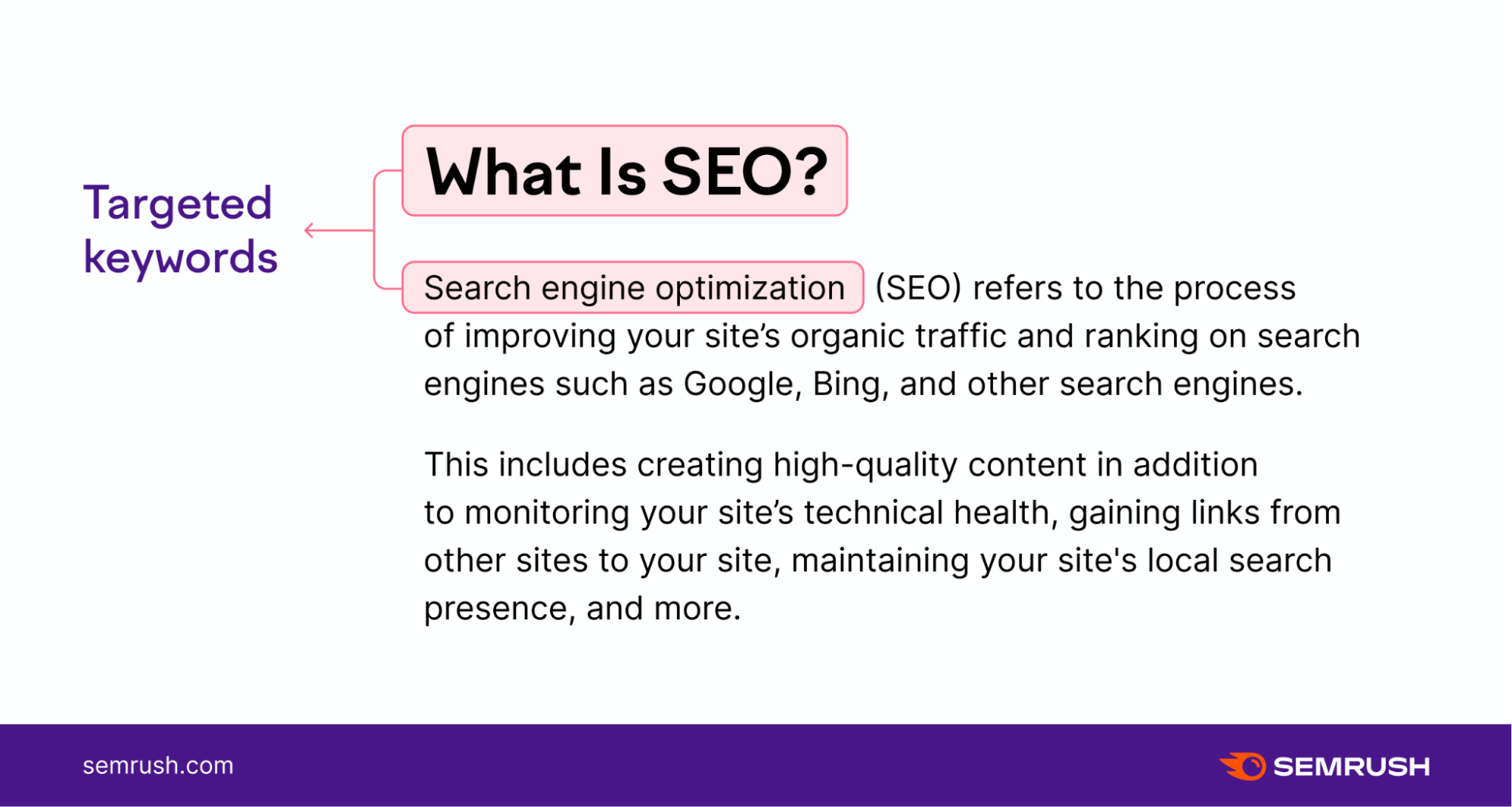
That way, Google can serve up relevant results that may not contain the exact keyword someone just searched for. And ultimately, bubble up relevant results to more people.
Authority
It’s one thing to determine a set of relevant results. But to actually put those results in order? That’s where authority comes into play.
Authority is Google’s way of figuring out which sites (and specific webpages) are highly trusted. Google largely uses the number of backlinks pointing to a page to determine authority.
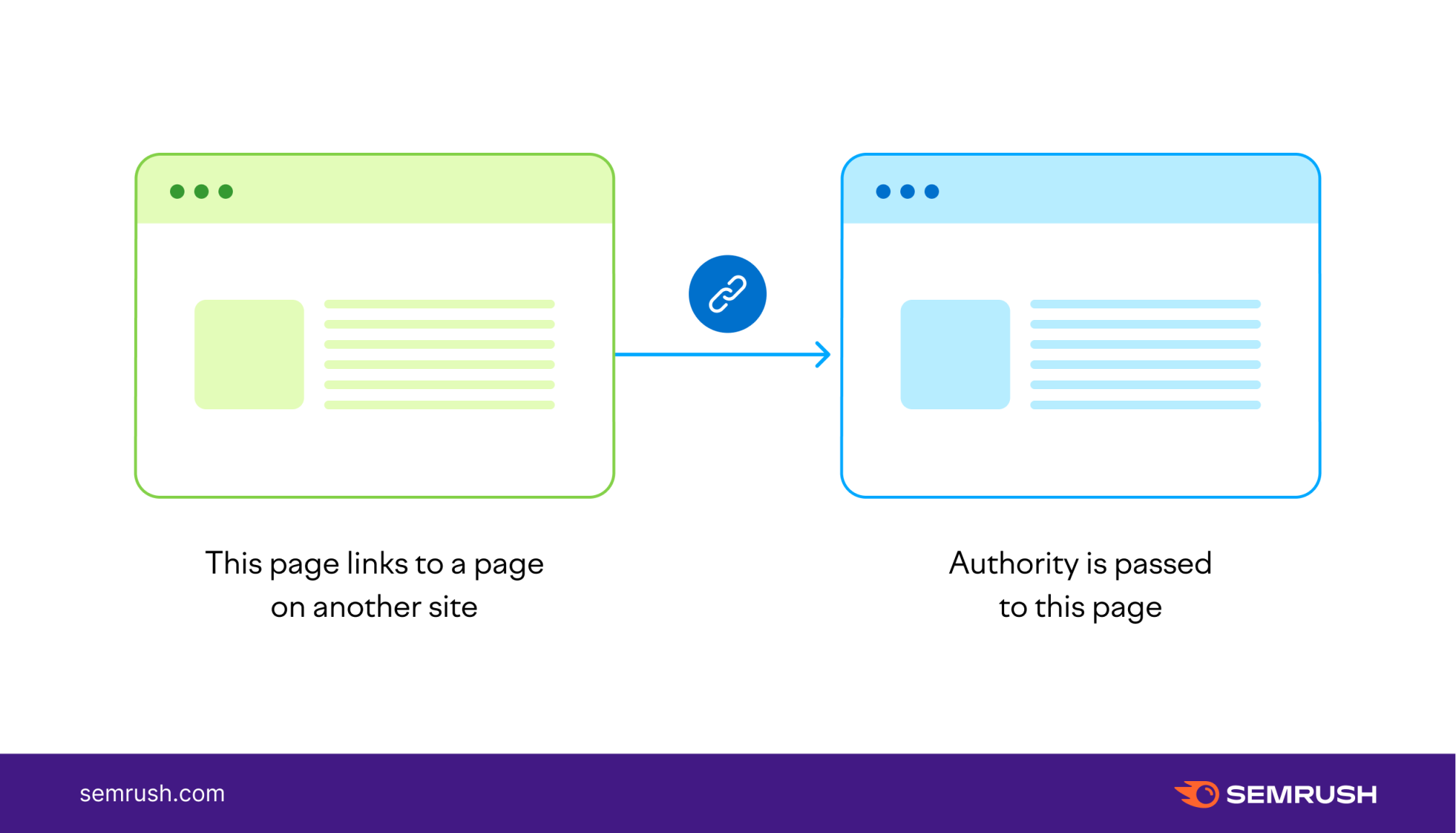
All things being equal, a page with lots of backlinks will outrank a page without any backlinks.
(It’s that important of a ranking factor.)
Content Quality
Content quality is the last of the “big three” Google ranking factors. Needless to say, “quality” is somewhat subjective. However, Google determines content quality not based on how good the writing is. Or how a page looks.
Instead, Google considers any page that satisfies search intent as “high-quality.”
In other words, let’s say you do a search for “best cat toys.”
Website #1 is a smaller site without a ton of authority. But the author of that site has published an amazing list of the best cat toys out there. Including lots of user reviews, pricing info, and more.
Website #2 is an older, established site in the pet niche. They have lots of authority. However, their list of the best cat toys is pretty thin. And makes it hard for users to find what they’re looking for.
In many cases, Website #1 will outrank Website #2.
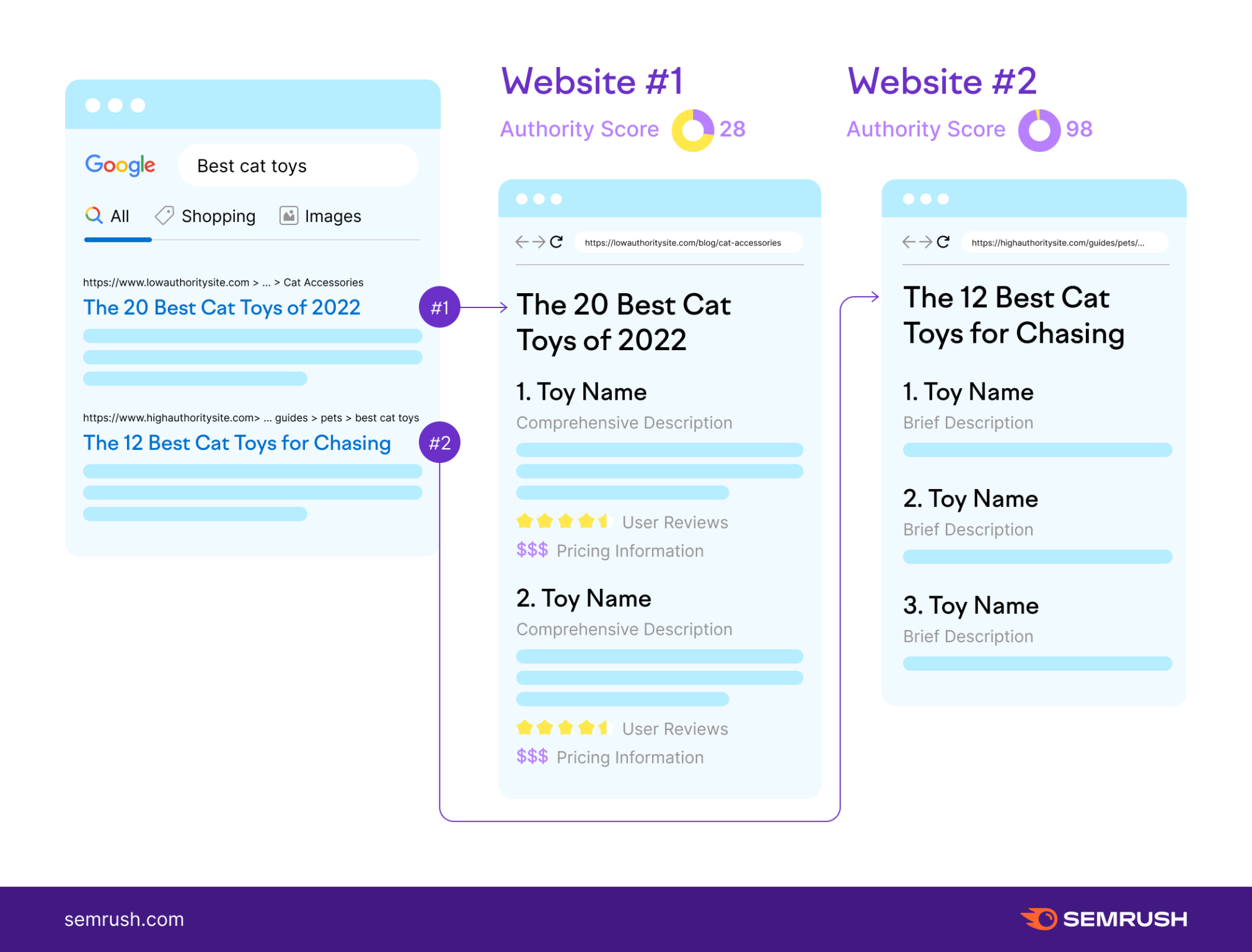
How to Get Higher Google Rankings
Now that you’ve learned how Google’s search engine algorithm works, it’s time for us to show you how to actually rank your site.
On-Page SEO
On-page SEO is the practice of optimizing your webpage content for search engines.
At a high level, the goal of on-page SEO is to help search engines understand what your page is all about.
Some on-page SEO techniques you can optimize for to accomplish that include:
Content Headlines and headers Title tags Meta descriptions Images Internal links Structured data URLs HTML code
Let’s say you have an article on your site about healthy dog food.
If you just wrote that article without thinking about SEO, Google might be able to understand what that page is all about.
But when you specifically optimize your content for search engines, you basically guarantee that Google will know that your page is about healthy dog treats.
Besides using your target keyword a few times on your page, other important on-page SEO strategies include:
Optimize around a single keyword: You want to optimize each page on your site for a single keyword (or a few variations of that keyword). Use your keyword in your title tag: Google puts more weight on text found in your title tag. So make sure to put your target keyword there (once). Internal linking: Linking to other pages on your site can help Google find, crawl, and index them. And can even help those pages rank higher in the SERPs. Page speed: Users will often leave a page if they don’t get the information they want quickly. Ensure that your page speed is fast enough by using Google’s PageSpeed Insight tool. If there are any issues, the tool will provide specific ways to speed things up.
Internal linking: Linking to other pages on your site can help Google find, crawl, and index them. And can even help those pages rank higher in the SERPs. Page speed: Users will often leave a page if they don’t get the information they want quickly. Ensure that your page speed is fast enough by using Google’s PageSpeed Insight tool. If there are any issues, the tool will provide specific ways to speed things up.
Off-Page SEO
Off-page SEO describes all SEO tasks that take place off of your website.
Why is off-page SEO important?
Well, Google and other search engines use off-page signals to determine how authoritative and trustworthy your site is. They especially rely on backlinks to help them figure out which sites have the most authority.
In other words, backlinks function as votes of confidence to search engines. That’s because a backlink from a high-authority site helps boost your site’s authority. Which can lead to higher rankings.
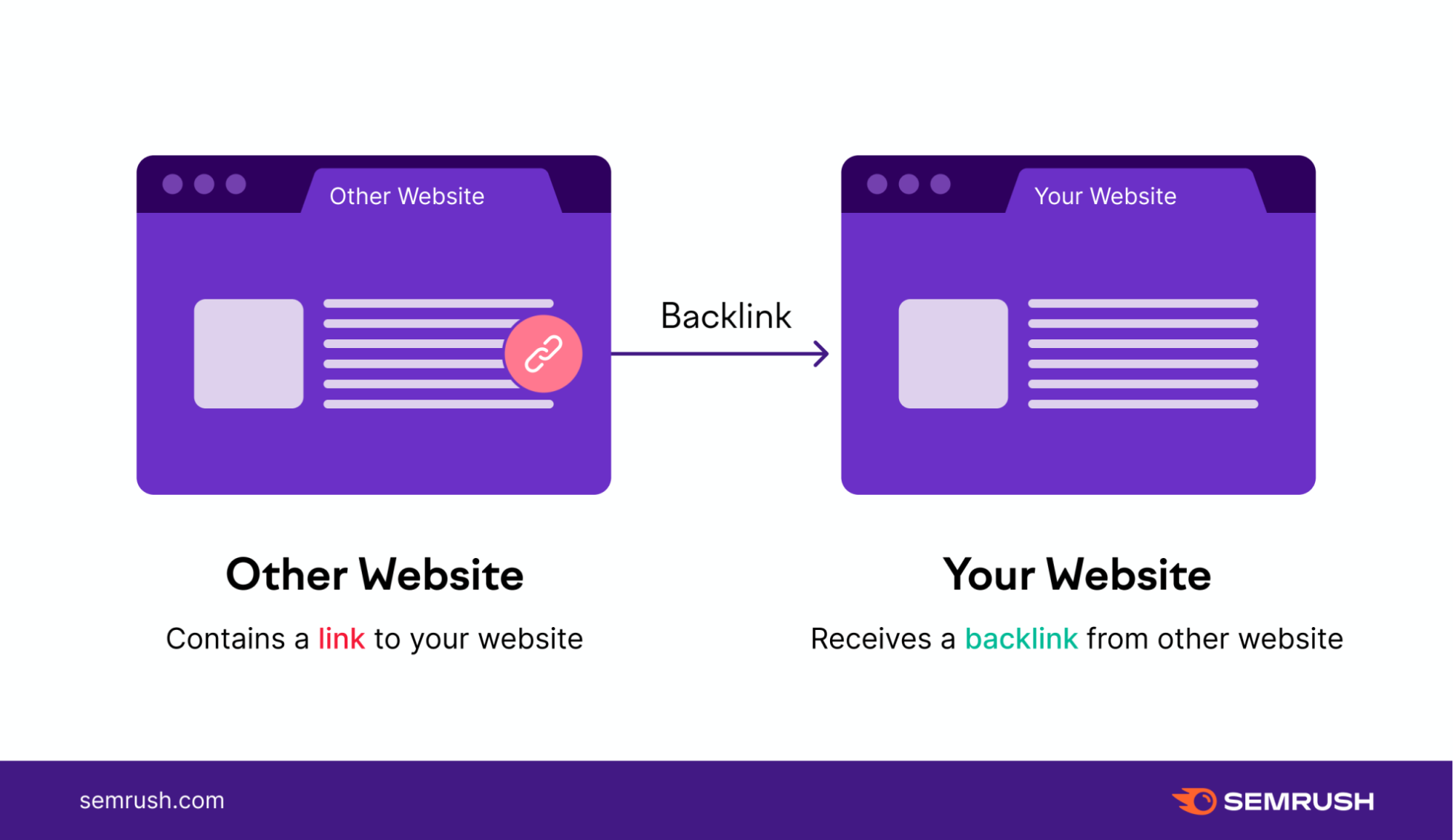
The practice of getting backlinks to your site is known as “link building.” However, while you do want to get as many high-quality links as possible, more links aren’t always better. Spammy backlinks won’t positively impact your site and can even lead to Google penalties, which can negatively impact your rankings.
Link building can be difficult and time-consuming. But considering that backlinks are essentially required to rank for nearly any keyword, it’s an important skill to learn.
We’ll dive deeper into link building later in this guide.
But for now, let’s cover some of the areas you’ll need to work on to rank higher on Google.
High-Quality Content
Google uses over 200 ranking factors in their algorithm. That said, the better your content, the higher your rankings will be.
Which means that you should spend most of your SEO efforts on creating awesome content vs. optimizing your title tags.
Writing great content is well beyond the scope of this guide.
That said, there are a few things you can do to publish the type of high-quality content that ranks on the first page of Google.
Cover Each Topic Thoroughly
Both Google and users want content that answers their questions thoroughly.
For example, one of our top-performing posts is “How to Perform an SEO Audit in 18 Steps.”
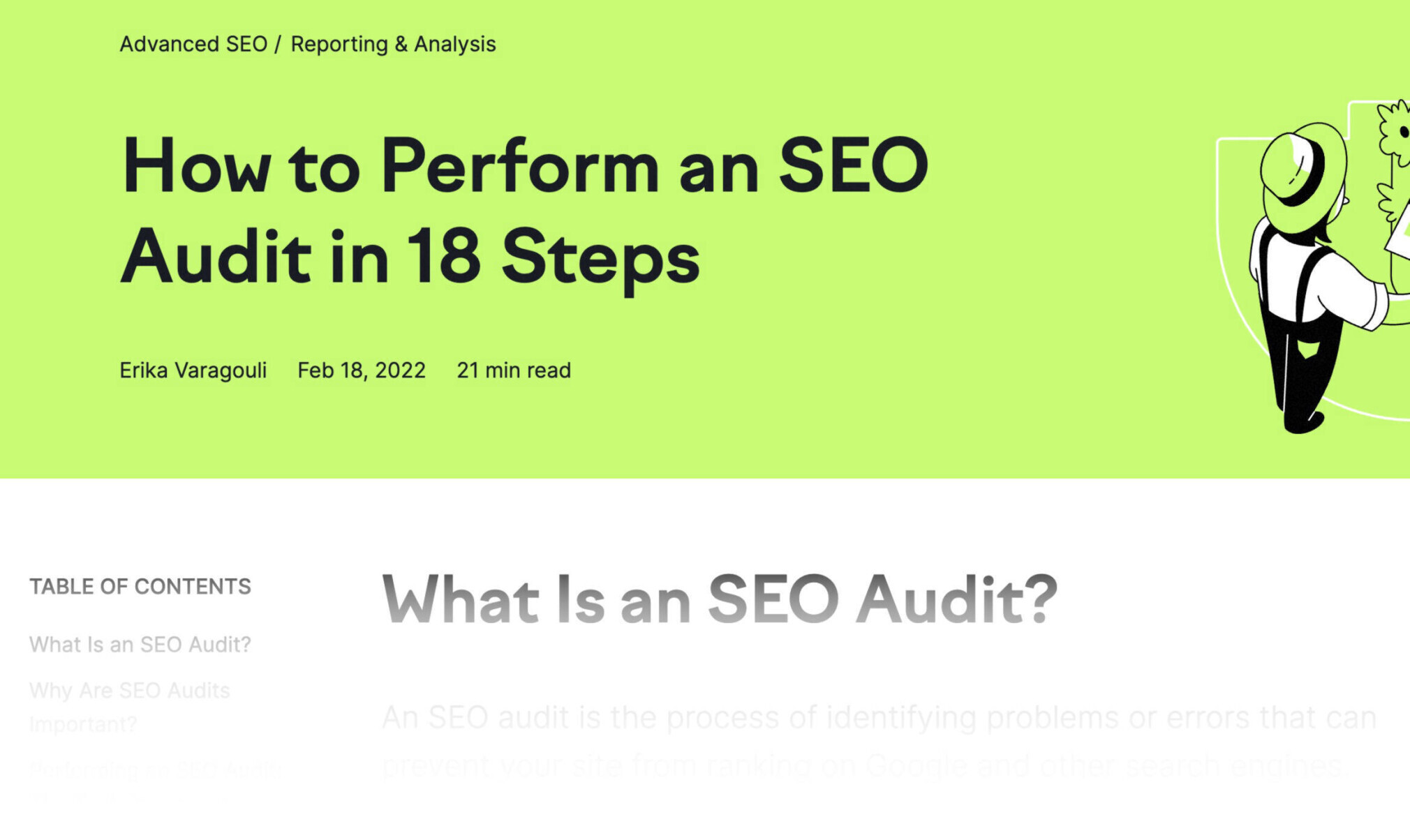
In fact, that page currently ranks #1 for the competitive keyword “SEO audit.”
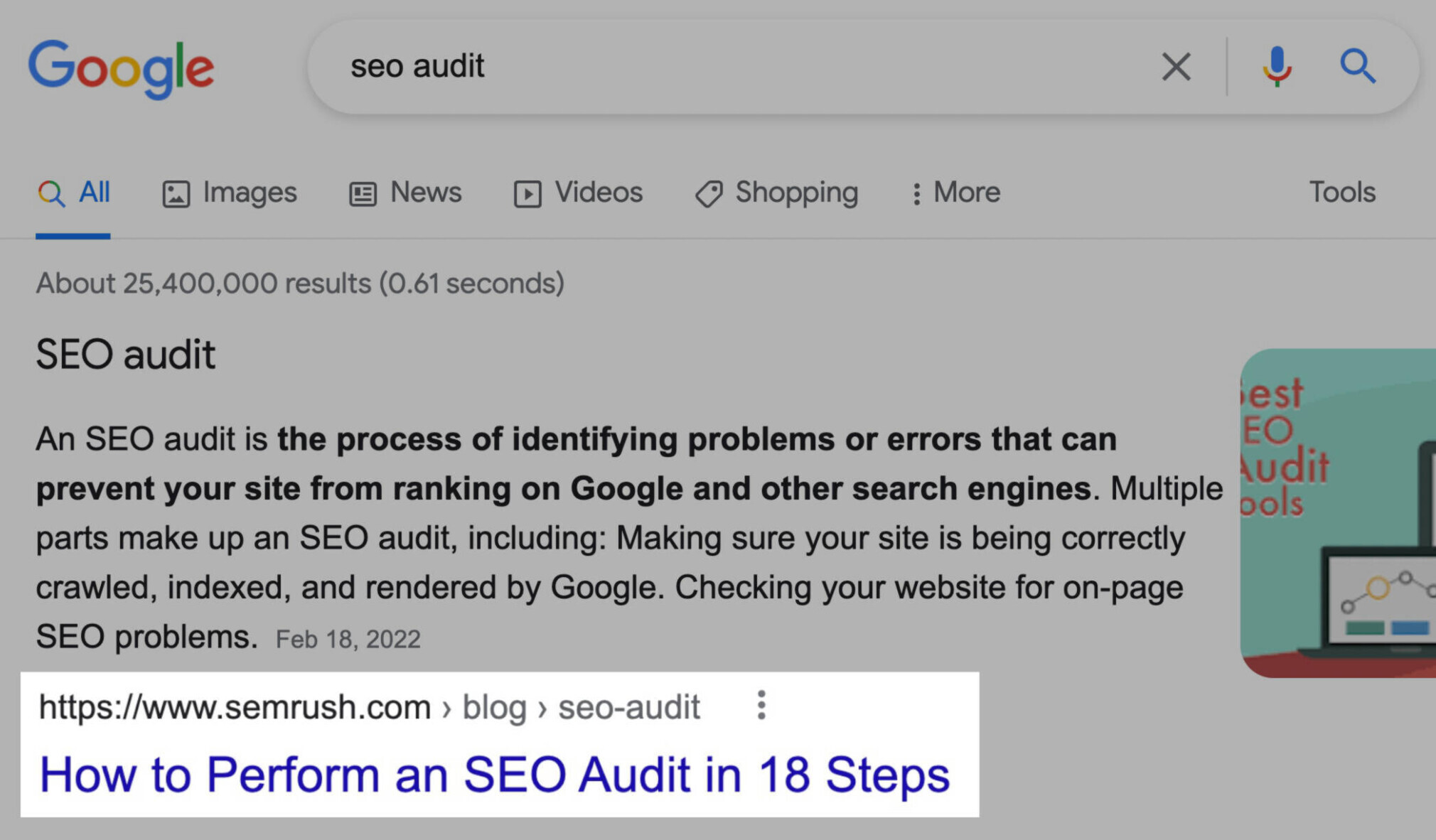
One of the reasons that this page ranks so highly?
Because it gives someone searching for “SEO audit” comprehensive info on that topic.
In fact, that single post is 5,117 words in length.
That’s not to say you want to pad your content’s word count. That will do more harm than good.
The idea is more to ensure that each page gives searchers a complete resource.
That way, users don’t need to visit any other resource to learn more.
Everything they need is right there on your site.
Write for Skimming
Google users don’t usually sit down and read every word on your page.
In fact, one study found that 84% of people skim the articles that they come across.
Which is why it’s important that your content is optimized for people that skim.
In practice, this means:
Use lots of section subheadings Include lots of checklists and bulleted sections Use short sentences and short paragraphs Don’t refer to content above where the user is (“as discussed earlier…”) Include generous amounts of visuals and embedded videosFor example, take a quick look at this screenshot from one of our posts.
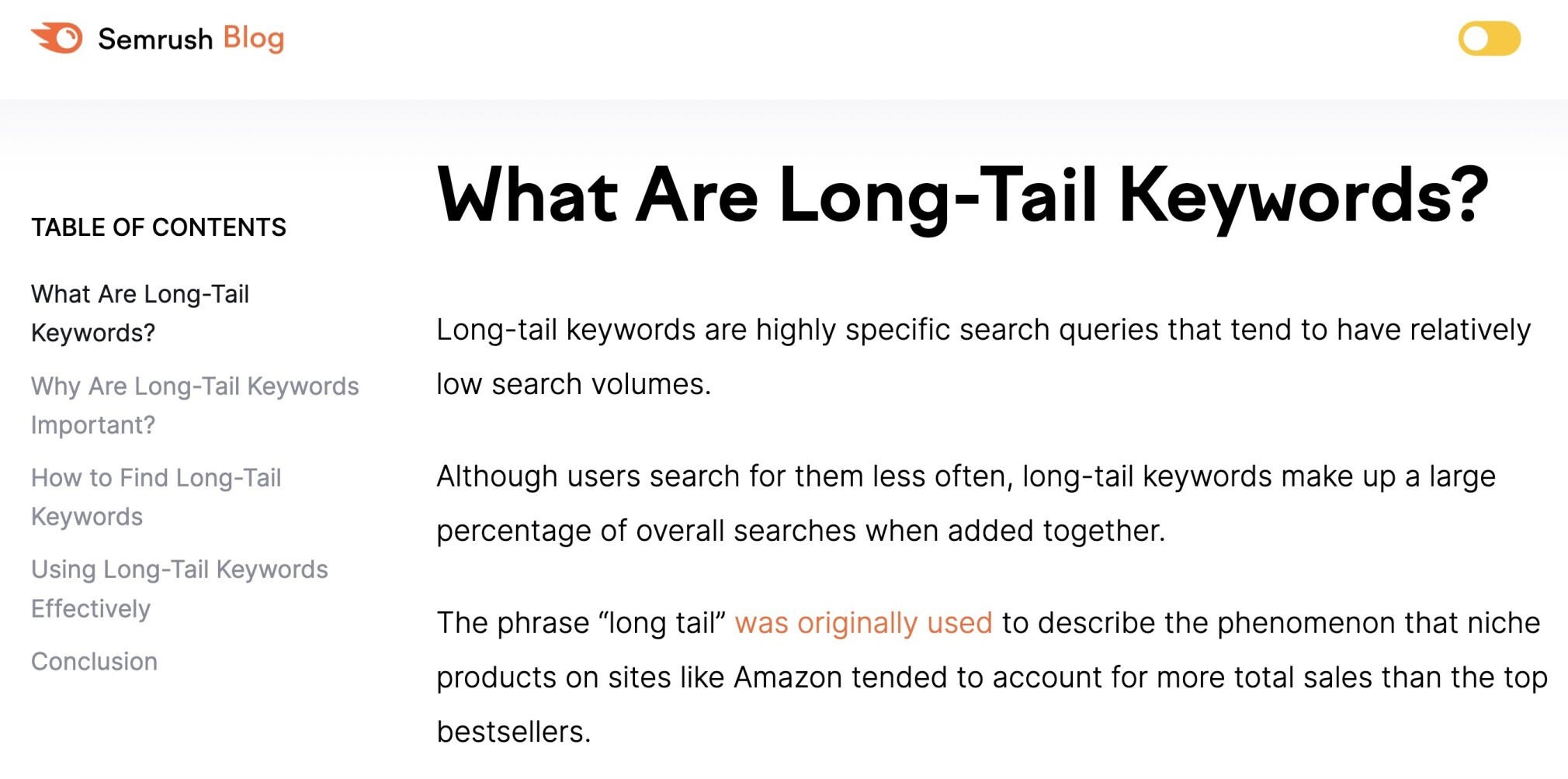
Notice how the content isn’t super dense. Instead, it’s easy to skim and grab the key points at a glance. That’s the goal.
Be Unique
There are already hundreds (if not thousands) of results for most high-volume keywords.
Which is why it’s important for your content to stand out in some way.
That doesn’t mean that you should reinvent the wheel. In fact, you want to generally stick to what’s already working (and improve upon it).
But that doesn’t mean that you can simply regurgitate the top 10 results and expect to hit Google’s first page.
Instead, you want to double down on what’s already ranking on page one. And add something unique that’s all your own.
Here are a few ways that you can help your content stand out from the current top 10 results:
Include more data: Studies, numbers, specific examples. All of these things can help make your content instantly stand out among a sea of vague statements. More relevant: Is most (or some) of the first page articles that haven’t been updated in years? If so, there’s a chance for you to sneak into the top 10 with something more up-to-date. More dense: Publish content that contains more value per word than the rest. More visuals: No likes reading a giant wall of text. Adding lots of visuals (especially custom-made visuals) is an easy way for your content to stand out.For more tips on creating content, read our comprehensive guide to SEO copywriting.
Technical SEO
Technical SEO is all about helping search engines find, crawl, and index all of the pages on your site you want them to (and none of them that you don’t).
Beyond that, technical SEO also includes your website’s overall performance and usability.
So yeah, it’s an important topic! And one we have a huge guide on that we recommend reading.
But for now, here are some of the key things to know about technical SEO:
Page Speed: Google ranks faster pages higher up in the search results since they have a better user experience. Mobile-friendliness: Users need to be able to consume your content easily on a mobile device. In fact, Google now evaluates your content based on its performance on a mobile device. User experience or interface: Users that land on your site should instantly be able to take some sort of action, whether that’s reading an article or navigating to a specific section of your site. Schema markup: Schema helps give Google more context about your content.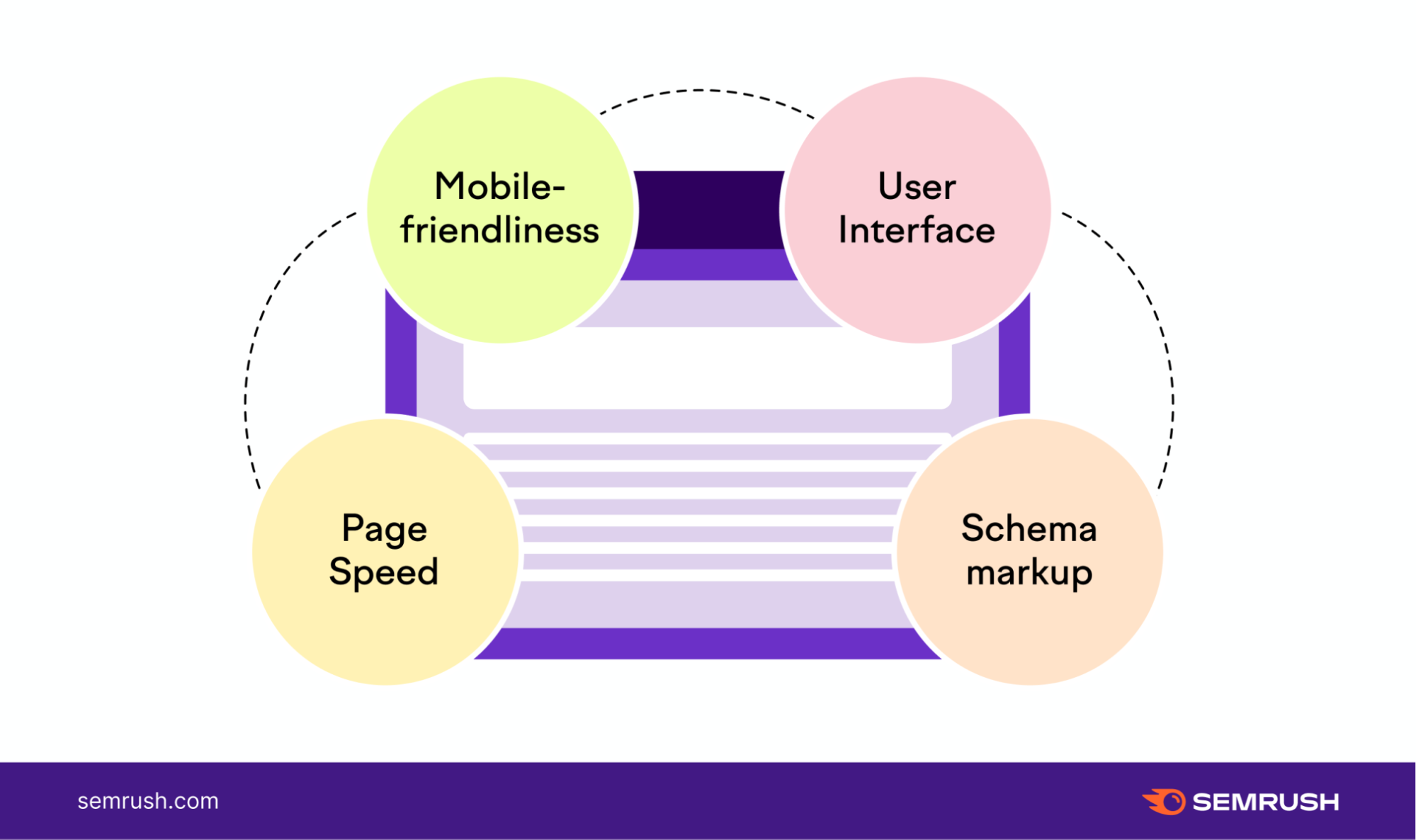
Website Architecture
Website architecture refers to how web pages are grouped and organized.
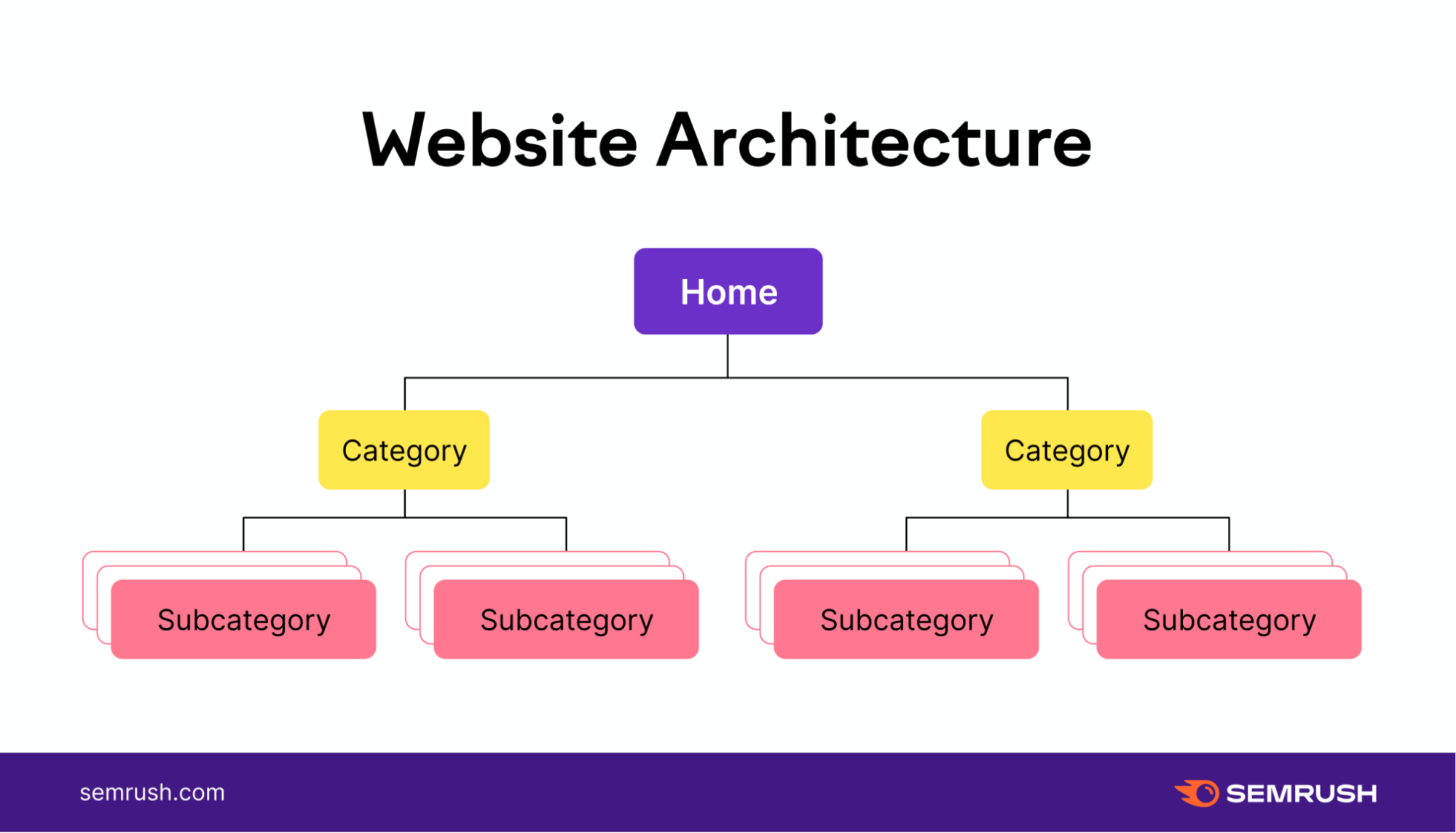
For most sites (like a small blog or small ecommerce site), site architecture isn’t super important. But if your site grows to 1,000+ pages, website architecture can start to impact your SEO.
Why is this important?
A well-organized architecture helps search engines find and crawl all of the pages on your website.
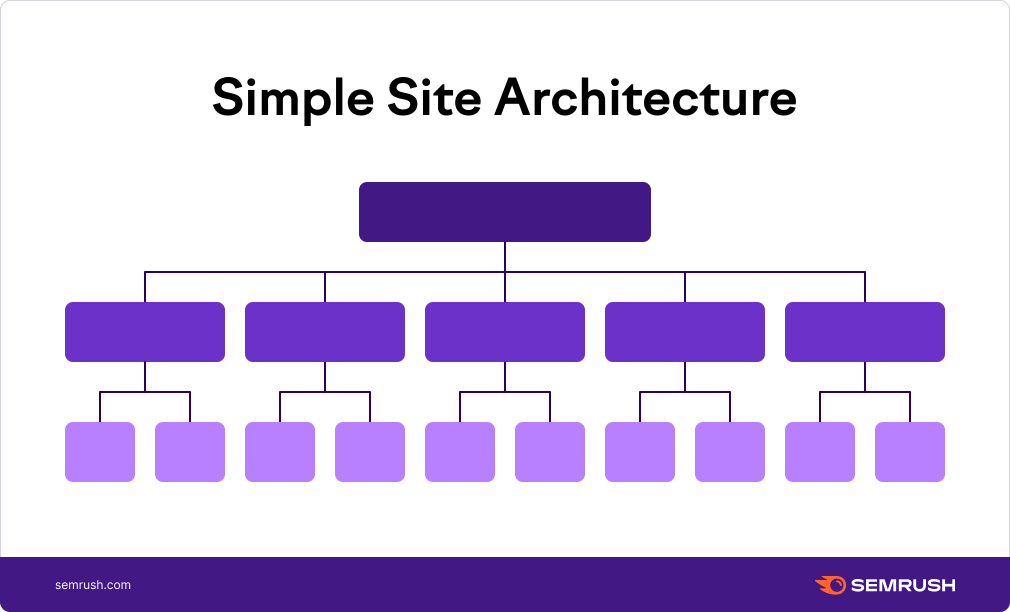
If your architecture is disorganized or new pages are several clicks away from your homepage, it can be hard for search engines to find those pages.
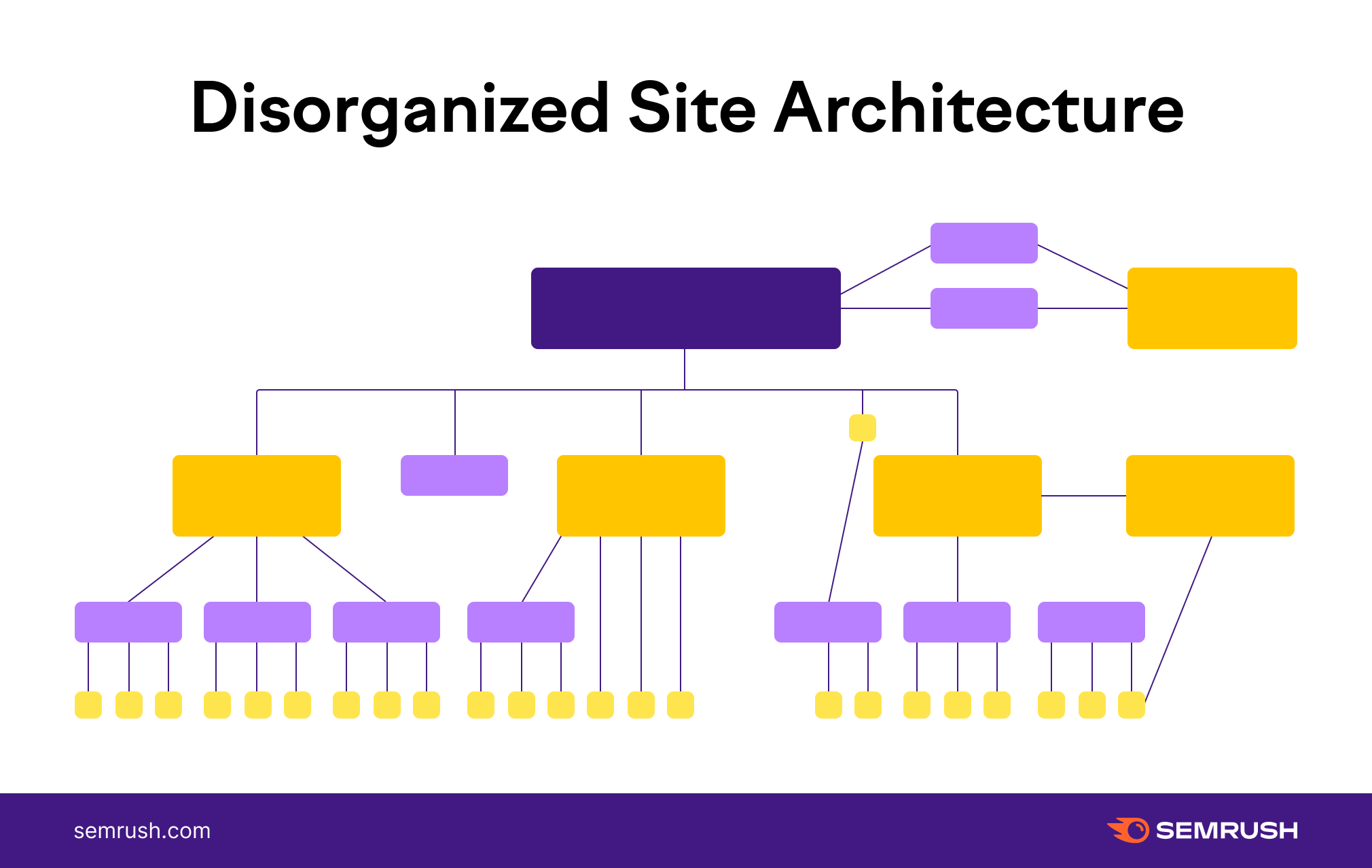
As a bonus, a clean site architecture ensures that link authority “flows” to all pages.
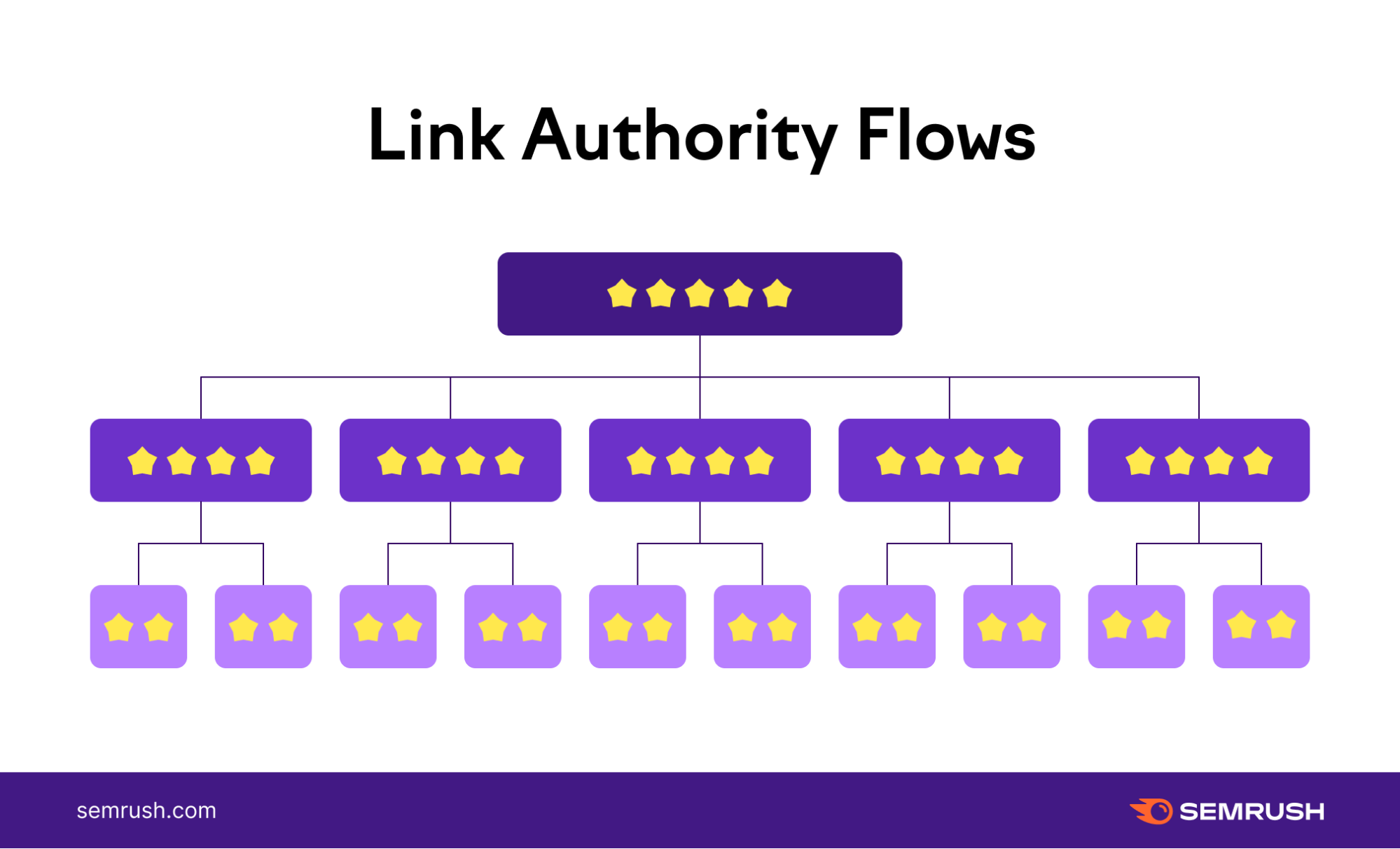
Link Building
Link building is the practice of getting other sites to add backlinks to your website.
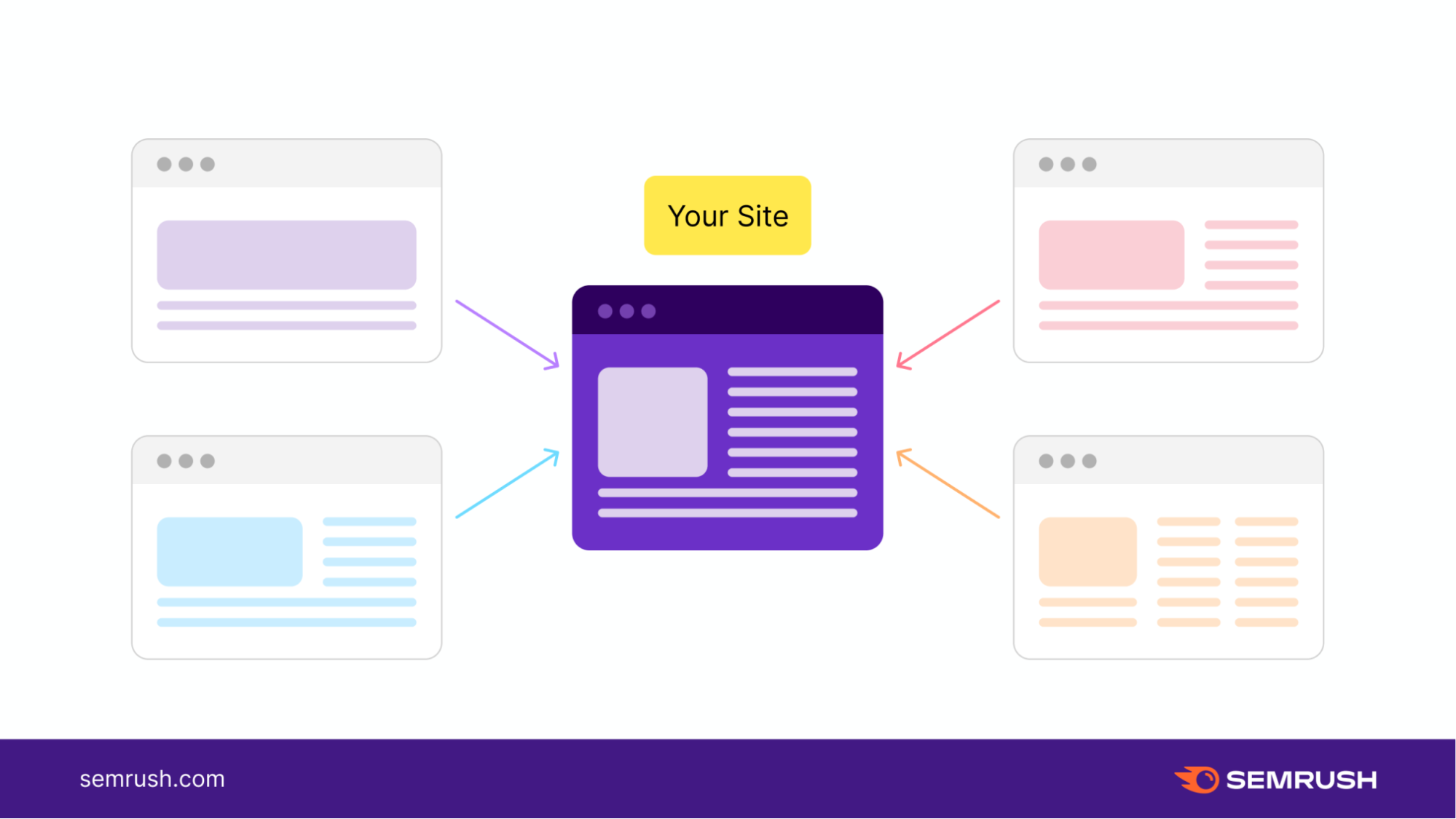
Considering that backlinks are essentially votes of trust and authority from other sites, they’re critical for ranking in Google.
In general, the more high-quality domains linking to you, the more authority your website has in the eyes of Google.
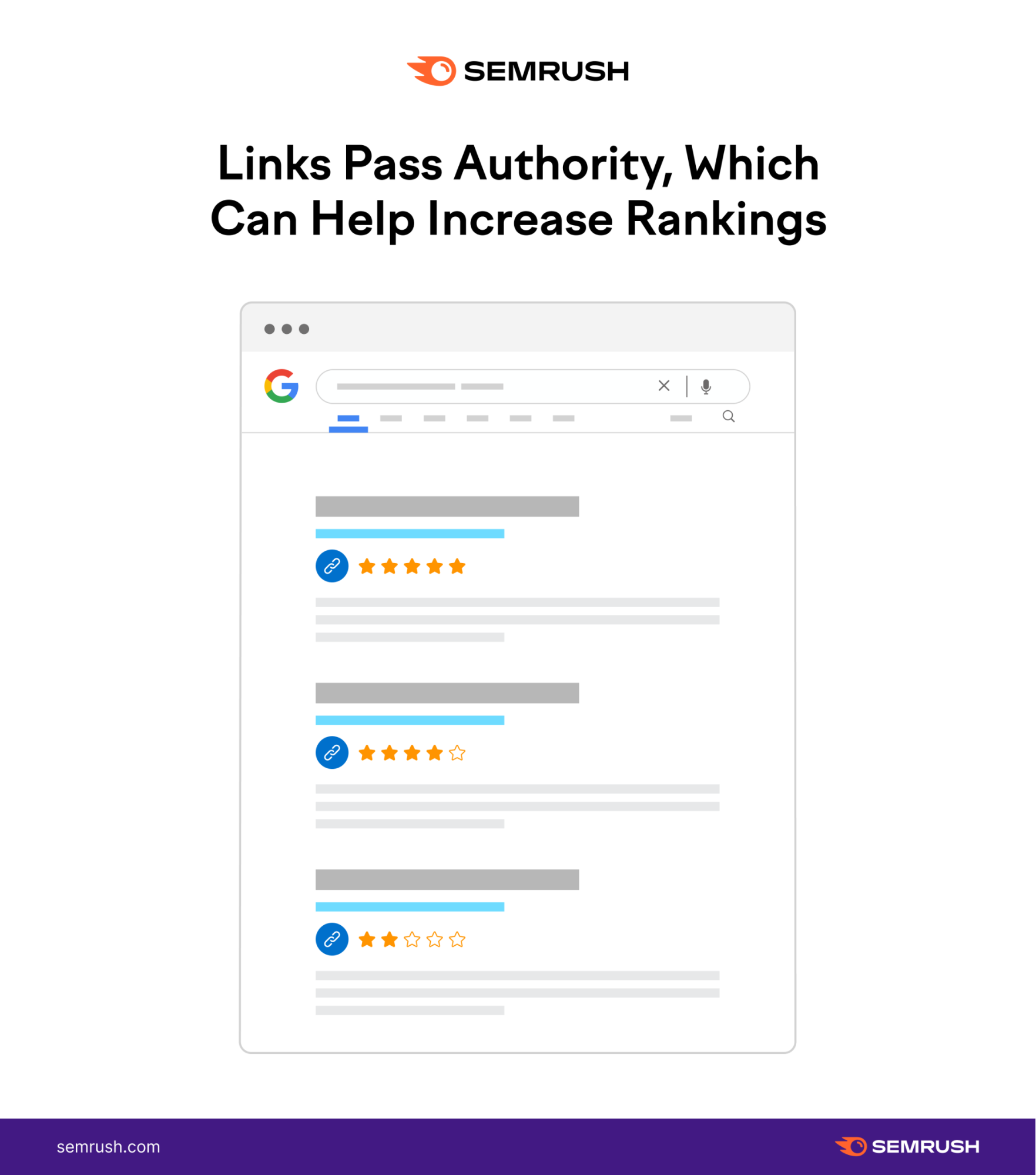
That said, you want to focus on quality (not quantity) when link building.
In general, a single backlink from a high-authority site will have more ranking power than 100 backlinks from irrelevant, low-quality websites.
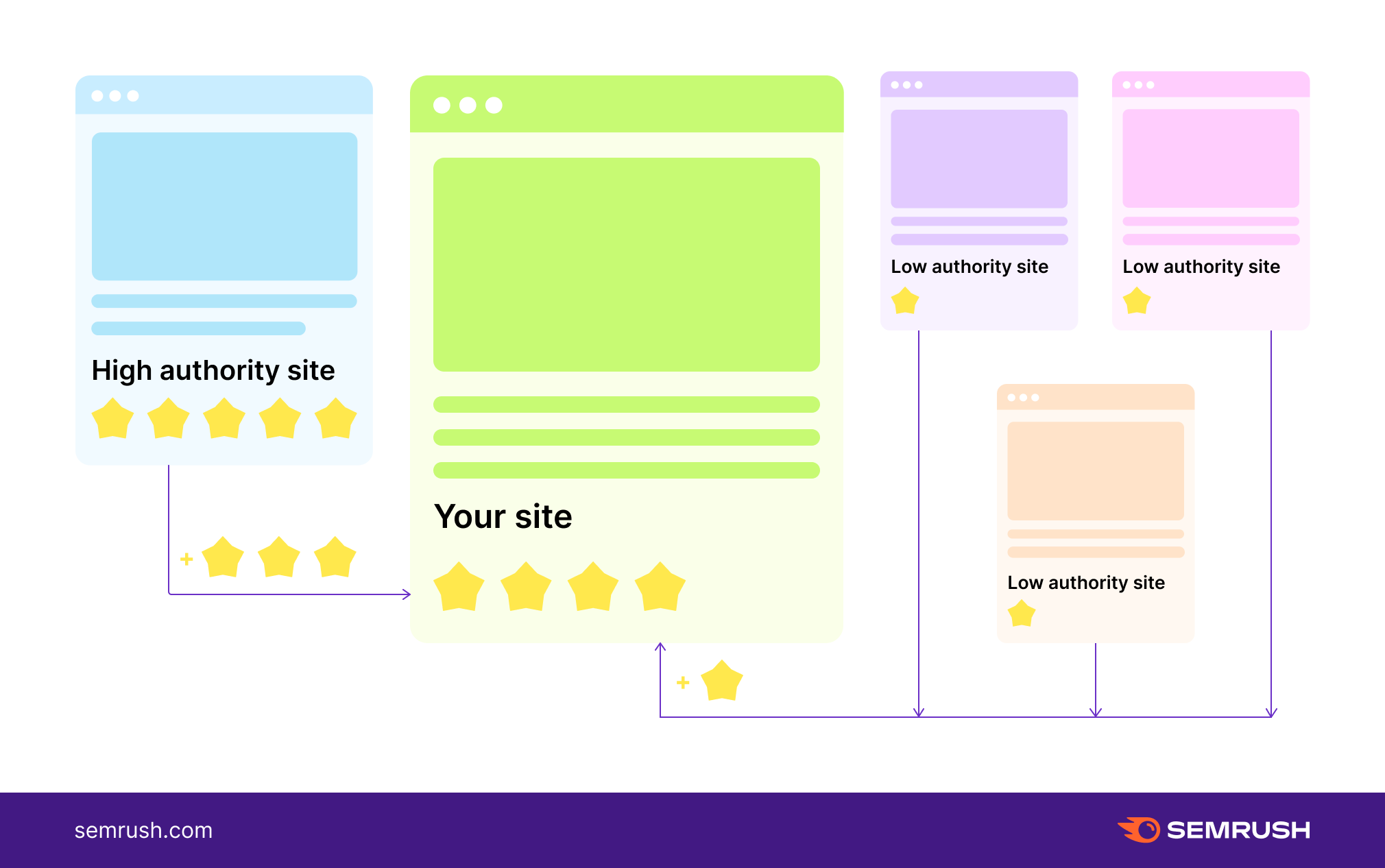
So link building is sort of a balancing act. Yes, you do want as many links as possible. But those links need to be from relevant, quality sites related to your site’s topic.
How to Build Links
In practice, link building consists of identifying people with the capacity to link to your content (website owners, journalists, bloggers, etc.), pointing them to your content, and encouraging them to link to it from a relevant page on their site.
Sounds simple in theory. But in practice, it can be tricky to convince someone to take time out of their day to add a link to your site.
Which is why you want to focus on these proven link building strategies:
Create linkable assets that people will want to link to Consistently share content on social media Participate in (strategic) guest posting Utilize broken link building Turn unlinked brand mentions into links Replicate competitors' backlinks Reclaim lost backlinksYou may need to build links manually in the early days of your SEO campaign.
However, over time, you want to transition to getting what are known as “passive links.” Essentially, links that people send to your site without you needing to actively build them.
You can do so by:
Creating useful, authoritative content within your niche Targeting the right keywords, which helps get your content in front of the right people Publishing visual content (like infographics) where people will link back to you as a source Publishing content that includes unique and helpful (or interesting) analysis of data, especially original dataAs an example, we published a study on “17 Most Prominent Google Ranking Factors” a few years ago.
This study contained boatloads of original data. Which, thanks to heavy promotion on social media, was seen by hundreds of digital marketing journalists and bloggers.
Many of those journalists and bloggers ultimately went on to write about our study (and link back to it).
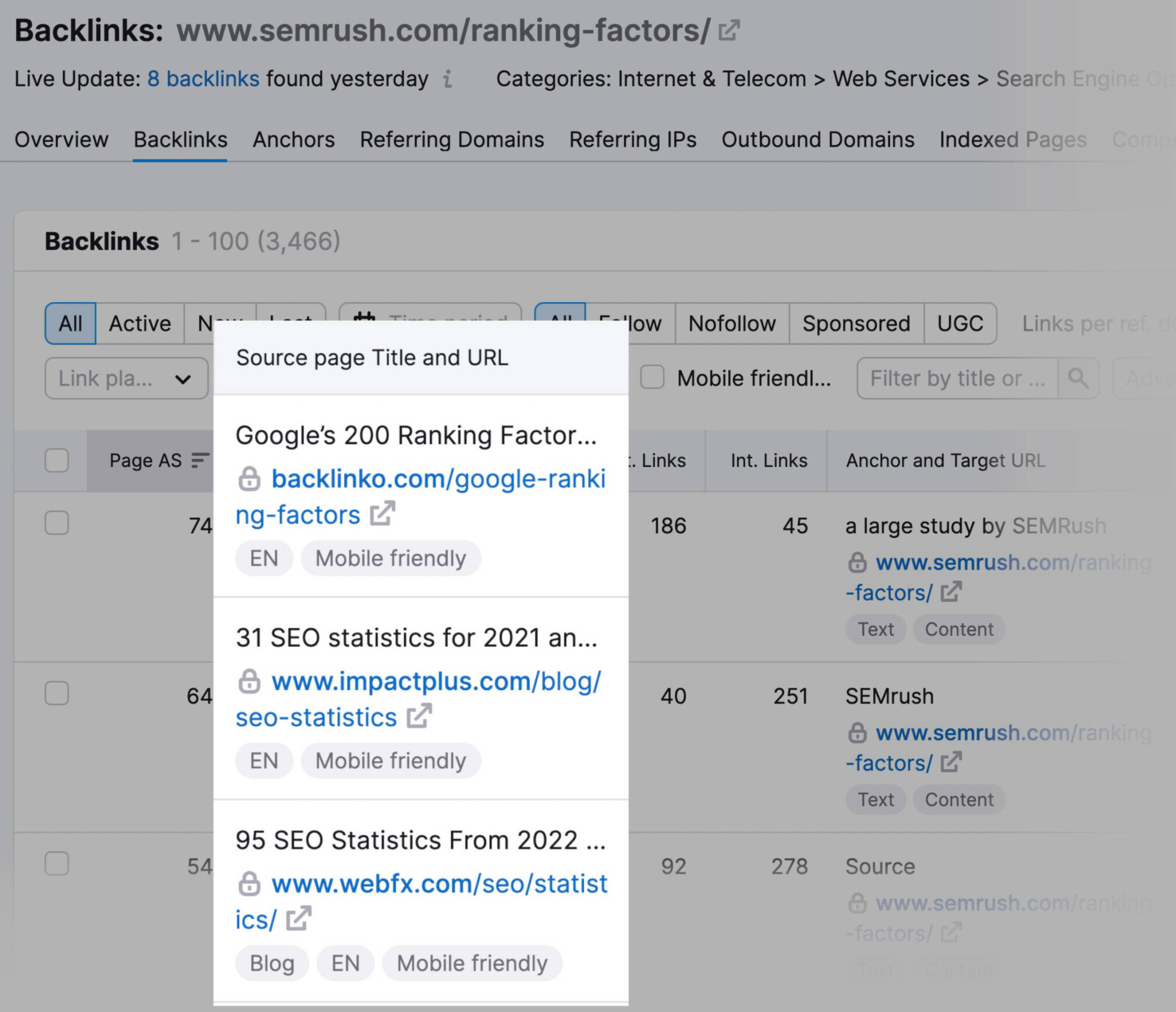
In fact, that page now has around 3,500 backlinks.
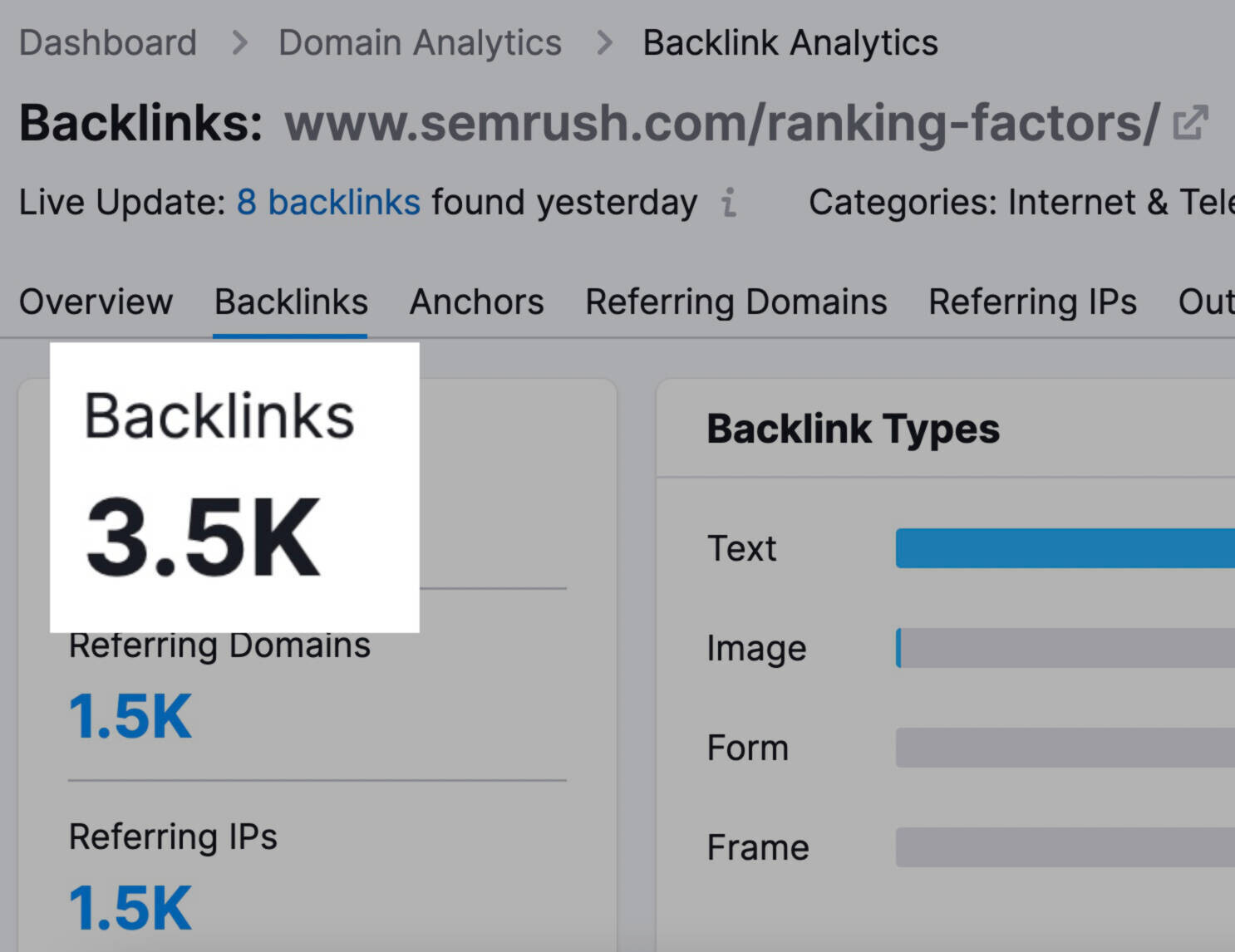
Local SEO
Local SEO is a subset of SEO designed to optimize a business’s online presence for local-specific search queries.
For instance, if you’ve ever looked up “car dealers near me” in Google, you were performing a location-specific search query.
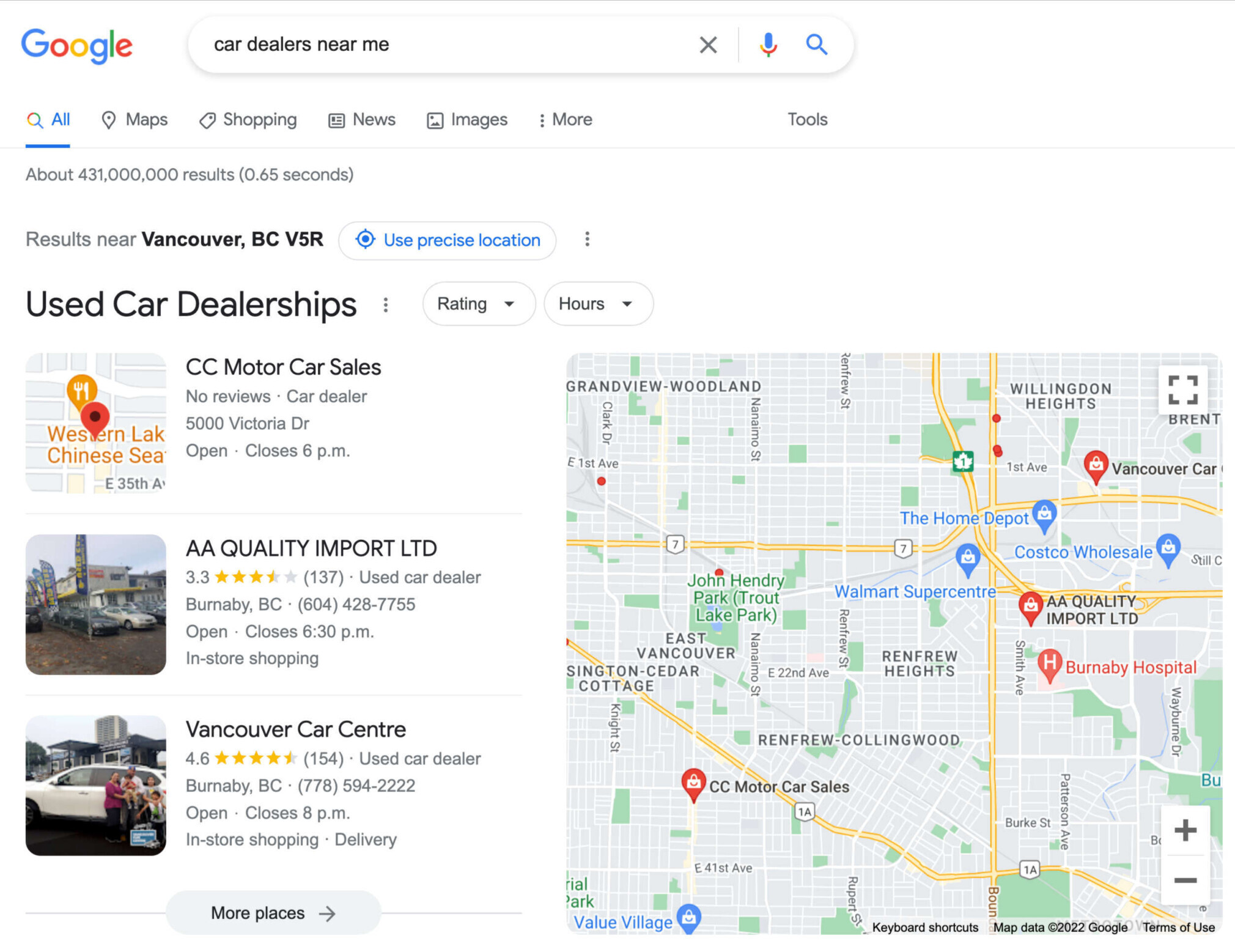
Location-specific queries yield results in three parts that make up what’s known as the “map pack”:
Google Maps results Local business results (including local citations in business directories) Organic search resultsHere’s how the results will appear:

Google Business Profile
Your Google Business Profile (formerly Google My Business) is the equivalent of your website for local SEO.
Your Google Business Profile gives Google (and users) key info about your business: address, opening hours, services offered, and more.
Then, Google uses your Google Business Profile to rank your profile for local queries using three main ranking factors:
Relevance: How relevant your business is for a searcher’s location-specific query. This is based on your business name, category, and description. Distance: Google calculates the distance of each relevant result from the user’s location. Prominence: This is essentially how popular your business is. This metric is calculated based on user reviews, your website’s authority, and citations.To learn more about optimizing your Google Business Profile, read our detailed guide.
Keep Learning About SEO
SEO is an art and a practice that takes time to learn. That said, it’s a skill that’s worth investing time into.
Want to learn about even more SEO strategies you can use to rank higher on Google? Check out these ten advanced techniques for SEO.
Want to watch some compelling content on SEO? Take a look at our webinar series on creating a winning SEO strategy.
And if you’re looking to take your SEO to the next level, take one of our free SEO courses in the Semrush Academy.
Innovative SEO services
SEO is a patience game; no secret there. We`ll work with you to develop a Search strategy focused on producing increased traffic rankings in as early as 3-months.
A proven Allinclusive. SEO services for measuring, executing, and optimizing for Search Engine success. We say what we do and do what we say.
Our company as Semrush Agency Partner has designed a search engine optimization service that is both ethical and result-driven. We use the latest tools, strategies, and trends to help you move up in the search engines for the right keywords to get noticed by the right audience.
Today, you can schedule a Discovery call with us about your company needs.
Source:





